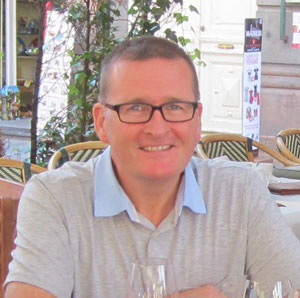This involves visits to the key wineries in the area, boat trips out to the bateas or mussel cultivation platforms to pair up freshly cooked mussels and Albariño. Calling in at Portomuiños, one of Europe’s leading edible seaweed farms, where you can taste delicious edible
Our mission is to show you the absolute best the region has to offer in terms of wine and food.
seaweed dishes. Those brave enough to bring a wetsuit can even swim out to the cultivation areas and see the briny stuff in its natural environment. For yachting enthusiasts, we do special charters out of Baiona, the first place in Europe to receive the news of the
discovery of America, with lots of wine and tapas of course! From January to April, you can learn all about lamprey cuisine. Galicia is one of Europe’s last strongholds for a dish once served at the Emperor’s table in Rome.
Adrian McManus is from the United Kingdom but has been living in Galicia since 1991. In 2002 he began writing for Living Spain Magazine, at the time the UK’s definitive publication on Spain and all things Spanish. His 2007 article on Cambados, “Cradle” of Albariño wine and its famous Fiesta del Albariño, Spain’s second most important date on the gastronomic calendar, caused something of a stir locally. In August of that year he was invited by the Most Serene Order of Albariño Wine to take the solemn oath of Knight

of Albariño Wine, an honour shared with only three other foreigners to date, General de Gaulle of France, President Juan Perón of Argentina and Swiss winemaker Dr. Bruno Kammerer. In June 2012 he was also proclaimed Defender of the Red Wine of the Salnés Valley in recognition for his contribution in the ‘defence and protection’ of the much loved Viño Tinto de Barrantes. His extensive contacts in the Galician wine industry have enabled him to be at the forefront of wine tourism in the region.
With a wild and spectacular scenery, the coastline of Galicia from Ribadeo at the mouth of the River Eo in the north, to the mouth of the River Miño at A Guarda in the south, is deeply cut by huge rías or estuaries, reminiscent of Scotland’s sea lochs. Inland it’s lush and wooded, thanks in part to the large amount of rainfall the region gets. The main attraction down the centuries has been the stunning old city of Santiago de Compostela, the third holiest site in Christendom after Jerusalem and Rome, which stands majestically at the end of the pilgrim trail.
Most people agree that Spain’s first real tourist industry began here. Since the ninth century pilgrims have been drawn to this beautiful city, allegedly the final resting
place of the apostle St. James. The climate is cool and damp in winter and warm and humid in summer. Many vineyards are located right by the sea, in the Rías Baixas, or lower estuaries, which gives Albariño its distinctive, mineral laden Atlantic character.
Inland, other forces come into play, with much higher temperatures, the same granite soils and steep meandering river valleys crested by oak, chestnut and eucalyptus forests. These intensely green valleys are dotted with ancient monasteries where the age-old tradition of winemaking has been handed down from generation to generation.
We cover all the major Denominaciones de Origen or wine appellations in the north-west of the Iberian
Peninsula. In Galicia we have the five sub-zones of D.O. Rías Baixas (Val do Salnés, Val do Ulla, Soutomaior, Condado do Tea and O Rosal), D.O. Monterrei, D.O. Ribeira Sacra and D.O. Valdeorras.
Over in neighbouring Castilla & León we have the wonderful Bierzo region and Mencía wines which are winning fans the world over. For those interested in the Portuguese version of Albariño, the Melgaço-Monçao Alvarinho area is well worth a visit.
Well off-the-beaten-track visits to furanchos, tiny vineyard-bar-restaurants licensed to sell their wines for only three months of the year (March-June), are a fabulous insight into Galician home cooking and local wine-making traditions.
